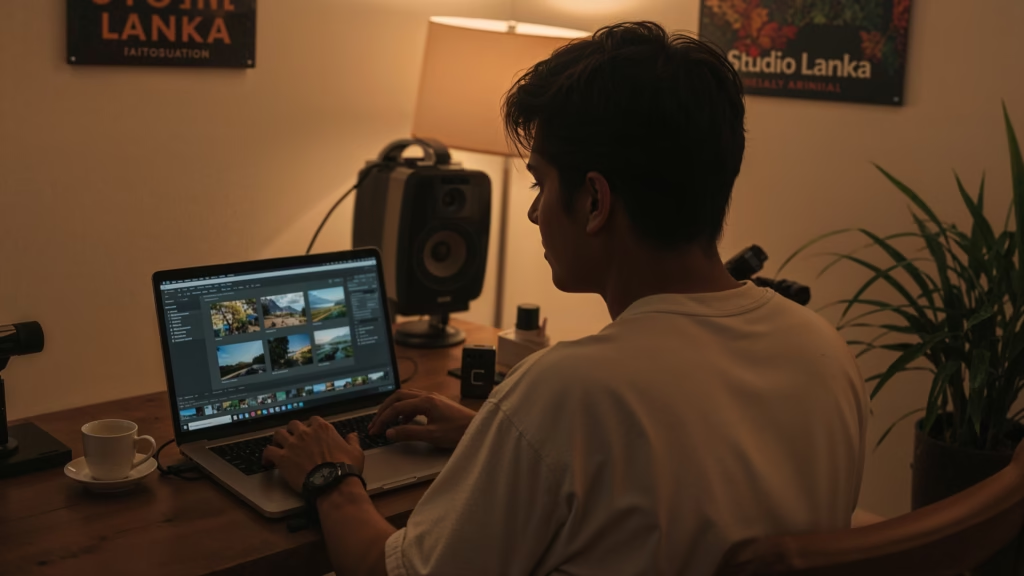Understanding Lightroom’s Interface
Adobe Lightroom is a powerful editing software that provides users with a Comprehensive interface tailored for photography. At the core of Lightroom are the two main modules—Library and Develop. Each module serves a distinct purpose in the photo management and editing process, making it essential for users, particularly Sinhala-speaking creators, to familiarize themselves with these components.
The Library module is instrumental in organizing and managing photo collections efficiently. When users first import their images into Lightroom, they become visible in the Library, where creators can assign ratings to their photos, add keywords for better organization, and create specific collections based on their preferences. This organization is crucial for any professional photographer, as it allows for quick access to images and seamless workflow management. The Library also lets users view metadata, making it easier to locate specific files and understand the details behind each photograph.
Transitioning to the Develop module, creators will find it packed with tools designed for photo editing. This is where the real magic happens, as users can adjust various aspects of their images. Key adjustments include exposure, contrast, highlights, shadows, and other visual elements that contribute to the overall aesthetic of a photograph. The Develop module not only allows for basic changes but also provides advanced options for fine-tuning the images, helping creators enhance their visual storytelling.
Understanding the roles of the Library and Develop modules is foundational for any editing process in Lightroom. By effectively managing photo collections in the Library and utilizing the editing capabilities in the Develop module, Sinhala-speaking creators can significantly enhance their photography skills and produce stunning visual content.
Basic Adjustments to Enhance Photos
In the realm of digital photography, meticulous editing is critical for transforming ordinary images into visually compelling works of art. One of the most powerful tools available for photographers is Adobe Lightroom, specifically within the Develop module. This software allows for precise adjustments that can significantly elevate the quality of photo collections. Among the key enhancements include exposure, contrast, highlights, shadows, whites, blacks, and the nuanced differences between color vibrance and saturation.
A primary adjustment often considered by photography enthusiasts is exposure. This adjustment determines the brightness of an image. When correcting exposure, creators need to find a balance; too much brightness can cause washed-out images, while too little can obscure important details. Similarly, contrast plays a crucial role in defining the separation between light and dark areas, bringing depth to an image. Adjusting contrast appropriately can create a more dynamic photograph.
Lightroom offers additional tools, such as highlights and shadows, which enable creators to refine the tonal range of their pictures. Adjusting the highlights allows one to recover details in the brighter parts of an image, while shadows adjustments can reveal details hidden in darker areas. Moreover, tweaking the whites and blacks sliders can help in fine-tuning the brightest and darkest elements of a photograph.
Another consideration in editing is the differentiation between color vibrance and saturation. While both enhance color in an image, vibrance adjusts less saturated colors and leaves skin tones more natural, making it ideal for portrait photographs. On the other hand, saturation uniformly increases the intensity of all colors, which may not always yield the desired results. Understanding these adjustments and when to apply them will prove invaluable for Sinhala-speaking creators aiming to produce stunning images through Adobe Lightroom.
Using Presets for Quick Edits
Presets in Adobe Lightroom offer a powerful yet efficient method for enhancing photography without the need for extensive manual adjustments. Essentially, presets are pre-defined settings that modify various editing parameters, such as exposure, contrast, saturation, and clarity. For Sinhala-speaking creators, utilizing presets can significantly streamline the editing process, transforming a series of photographs into visually cohesive collections with just a few clicks. This is particularly beneficial when working with Sri Lanka’s vibrant landscapes and rich cultural events, where consistency in style is essential.
There are an abundance of both free and paid presets available, each designed to enhance specific aspects of photography. Free presets might cater to general editing needs, while paid options often provide more tailored adjustments that perfectly suit the colors and tones found in Sri Lankan scenes. For example, using a preset that enhances the lush greens of tea plantations or accentuates the warm hues of traditional festivals can elevate the overall impact of your photographs. By applying these specific settings, you can maintain a consistent aesthetic across your entire photo collection, ensuring that each image complements the others.
Creating custom presets allows Sinhala-speaking creators to develop a unique style that resonates with their artistic vision. To do this, adjust settings such as exposure levels, contrast, highlights, shadows, and color toning in the Develop module. Once satisfied with your adjustments, simply navigate to the Presets panel and select ‘Create Preset.’ Give your new preset a distinctive name and save it for future use. This process not only saves time during the editing phase but also ensures that your specific style is preserved across various projects. In conclusion, leveraging presets in Adobe Lightroom can significantly enhance the workflow of creators while providing unique, stylistic edits that honor the beauty of Sri Lanka.
Organizing Photos with Sinhala Folder Names
Organizing photos in a structured manner is crucial for efficient management, especially for creators working with extensive libraries. By employing Sinhala script for folder names and tagging, Sinhala-speaking creators can enhance their photo organization significantly. Utilizing localized naming conventions allows users to categorize images in a way that resonates culturally and linguistically, leading to a more intuitive navigation experience.
One of the primary advantages of localized naming is improved memory retention. For instance, if a creator is managing a collection of nature photography, using Sinhala terms such as “ප්රක්ෘති” (prakruthi) for nature, “සංසරණ” (samsarana) for travel, or “ආශ්්රිත” (ashritha) for landscape can evoke stronger associations than generic English terms. This personalized approach not only makes it easier to locate specific photos but also enriches the creator’s connection to their work.
When organizing photo collections, it is beneficial to establish clear and logical categories. For example, a folder structure could include sections for family events (“ගෙදර”), professional work (“මේලය”), and travel experiences (“සමණලියන්”). These categories allow for streamlined access to images when utilizing editing software like Adobe Lightroom or when necessary edits are made in the develop module.
Additionally, having organized folders with Sinhala names can facilitate collaboration among Sinhala-speaking creators. It can make sharing and discussing edits easier, as everyone involved can understand and navigate the folder structures without language barriers. This not only enhances workflow efficiency but also encourages a supportive community among creators. By embracing culturally relevant naming conventions, Sinhala-speaking photographers can foster a more intuitive approach to managing their imagery, ultimately leading to more effective editing and presentation of their work.
Backing Up Your Lightroom Catalog
For any photographer, especially for Sinhala-speaking creators, the protection of their hard work must be a priority. Adobe Lightroom relies on its catalog to store all metadata and edits for your photo collections, making the catalog vital for preserving your photography projects. Regularly backing up your Lightroom catalog not only keeps your edits secure but also acts as a safety net in case of a system failure or accidental data loss.
The Lightroom catalog is essentially a database that contains all the information about your images, including adjustments made in the Develop module—such as exposure and contrast settings. Therefore, if the catalog file becomes corrupted or lost, so too are your valuable edits and any associated metadata. To mitigate this risk, it is advisable to implement a consistent backup strategy.
One effective method is to save your Lightroom catalog on an external drive. This offers a level of physical security that can shield your work from local hardware failures. To create a backup, navigate to the ‘Catalog Settings’ within Lightroom’s preferences. Here, you can schedule a backup prompt, ensuring that you are regularly reminded to safeguard your work. When backed up to an external drive, it is important to employ proper organization, naming the backup files clearly to avoid any confusion over versions.
Alternatively, utilizing cloud storage can be another prudent strategy, where your catalog files are stored remotely, providing access from different devices and added protection from loss. Services like Adobe Creative Cloud can offer a robust solution for storing and managing Lightroom catalogs securely. By combining these approaches, Sinhala-speaking creators can ensure that their edits remain intact, allowing them to focus on enhancing their photography without the looming fear of losing their progress.
Exporting for Social Media and Print
Exporting images effectively for various platforms is crucial for Sinhala-speaking creators aiming to showcase their photography. Adobe Lightroom offers a robust set of tools within the Develop Module to facilitate this process. When preparing images for social media platforms like Instagram and Facebook, it is essential to consider file formats, resolutions, and color profiles to ensure your photographs are displayed at their best. The preferred file format for social media is typically JPEG, as it balances quality and file size efficiently.
For Instagram, images sized at 1080 pixels wide are ideal, as they maintain a high level of detail while adhering to platform specifications. The sRGB color profile is recommended for social media uploads, ensuring colors appear consistent across devices. Additionally, maintaining an exposure that is neither too bright nor too dark, along with appropriate contrast levels, will enhance your images’ visual appeal on these platforms.
When exporting for print, different considerations come into play. High-resolution images are essential, usually around 300 DPI (dots per inch). The TIFF format is often chosen for prints, as it preserves the quality of the photo collections much better than other formats. Photographers should also ensure that the color profile is set to Adobe RGB, as this provides a broader range of colors suitable for high-quality prints.
Understanding these export settings allows photographers to present their work effectively, whether on social media or in physical prints. By optimizing exposure, contrast, and file format, Sinhala-speaking creators can enhance the reach and impact of their photography, ensuring that each image captures the attention it deserves. Mastering these exporting techniques will significantly benefit any photography collection shared online or in print, allowing creators to showcase their art at the highest quality.
Conclusion
Mastering Adobe Lightroom’s basic functionalities is pivotal for Sinhala-speaking creators in the realm of photography. This powerful editing software offers a wide array of tools that can significantly enhance photo collections, enabling photographers to showcase their work in a more compelling manner. By understanding the essentials, such as the develop module, exposure adjustments, and contrast settings, creators can significantly elevate the quality of their visual outputs.
Regular practice with these foundational features allows Sinhala photographers to experiment confidently with various techniques, ultimately leading to a refined editing style that captures the essence of Sri Lanka’s diverse and rich visual culture. It is essential to not merely replicate existing styles but to draw inspiration from the world around while developing a unique aesthetic that tells a personal story through their imagery.
As creators continuously explore the functionalities of editing software like Adobe Lightroom, they will find opportunities to innovate and grow their artistic expression. Each photograph offers a chance to apply new skills and insights gained through regular experimentation. Building a robust editing routine will not only improve one’s familiarity with the software but will also empower photographers to push the boundaries of their creativity.
In summary, commitment to mastering the basic tools of Lightroom is a significant step for Sinhala photographers dedicated to advancing their craft. It is through continuous learning and experimentation that they will develop a unique voice in their photography, ultimately enriching the visual narrative of their surroundings. The journey of enhancement and personal growth in photography is ongoing, and every interaction with the software contributes to a greater understanding of one’s artistic vision.

